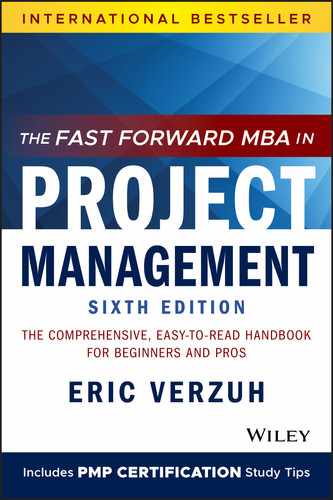NOTES
CHAPTER 2
- 1. Daniel Coyle, The Culture Code: The Secrets of Highly Successful Groups (London, Random House Business Books, 2018).
- 2. John French and Bertram Raven, “The Bases of Social Power,” in Dorwin Cartwright (ed.), Studies in Social Power (Ann Arbor, MI: Institute for Social Research, 1959).
- 3. Joel DeLuca, Political Savvy: Systematic Approaches to Leadership Behind‐the‐Scenes, 2nd ed. (Berwyn, PA: EBG Publications, 1999).
- 4. Rick Brandon and Marty Seldman, Survival of the Savvy: High‐Integrity Political Tactics for Career and Company Success (New York: Free Press, 2004).
CHAPTER 4
- 1. Tim Brown, Change by Design (New York: HarperCollins, 2009).
- 2. Mark C. Paulk, Charles V. Weber, Bill Curtis, and Mary Beth Chrissis, Capability Maturity Model for Software. CMU/SEI‐91‐TR‐24. (Pittsburgh: Carnegie Mellon University, Software Engineering Institute, 1991).
- 3. Project Management Institute, A Guide to the Project Management Body of Knowledge, 5th ed. (Newtown Square, PA: PMI, 2013), pp. 44–45.
- 4. Todd Mosher, James Kolozs, Carissa Colegrove, and Erica Wilder, “Agile Hardware Development Approaches Applied to Space Hardware,” Syncroness, Westminter, CO, 2018. AIAA SPACE Forum, https://arc.aiaa.org/doi/pdf/10.2514/6.2018-5233 .
CHAPTER 6
- 1. Robert Miller and Stephen Heiman describe this decision maker in their book Strategic Selling (New York: Warner Books, 1985). While theirs is primarily a book about selling, any project manager promoting organizational change will benefit from understanding the decision‐making processes outlined in their book.
CHAPTER 8
- 1. Readers can obtain a copy of the Software Engineering Institute's Continuous Risk Management Guidebook at https://resources.sei.cmu.edu/.
CHAPTER 13
CHAPTER 14
- 1. Heather Maxwell Chandler, The Game Production Handbook (3rd ed.) (Sudbury, MA: Jones and Bartlett Learning, 2013).
- 2. Jerry Ziesmer, Ready When You Are, Mr. Coppola, Mr. Spielberg, Mr. Crowe (Vol. 69) (Scarecrow Press, 2003).
- 3. Clinton Keith and Grant Shonkwiler, Creative Agility Tools: 100+ Tools for Creative Innovation and Teamwork (Clinton Keith, 2018).
- 4. Jonathan Feist, Project Management for Musicians: Recordings, Concerts, Tours, Studios, and More (Hal Leonard Corporation, 2013), p. 16.
- 5. David Pogue, “What Makes a Hit?” Video file. https://www.youtube.com/watch?v=3npQwZTqv-Q (January 26, 2020).
- 6. Sasha Frere‐Jones, “STYLE; The Sound.” https://www.nytimes.com/2004/02/08/magazine/style-the-sound.html (2004).
- 7. Alan Hicks (writer and director) and Rashida Jones (writer and director). Quincy (Netflix, 2018).
- 8. Michael Leser, “Without Sports, Project Management Would Be Hard!” Paper presented at PMI® Global Congress 2010—North America, Washington, DC (Newtown Square, PA: Project Management Institute, 2010).
CHAPTER 15
- 1. David P. Hanna, Designing Organizations for High Performance (New York: Prentice Hall, 1988).
- 2. Kristin Arnold, “Making Team Decisions,” in Elaine Biech (ed.), The Pfeiffer Book of Successful Team Building Tools (San Francisco: Pfeiffer, 2001), p. 157.
- 3. The responses to conflict have been written about widely. The original reference on this topic is R. R. Blake and J. S. Mouton, The Managerial Grid (Houston: Gulf Publishing, 1964).
- 4. Roger Fisher and William L. Ury, Getting to Yes: Negotiating Agreement Without Giving In (New York: Penguin Books, 1991). To some degree, all the guidelines for working through conflict are expressed in this useful book. In particular, guideline 4 comes directly from Chapter 3.
- 5. John C. Redding, The Radical Team Handbook (San Francisco: Jossey‐Bass Business & Management Series, 2000), pp. 64–65.
- 6. Ibid., pp. 89–90.
- 7. Ibid., p. 103.
- 8. Peter Senge, The Fifth Discipline: The Art and Practice of the Learning Organization (New York: Doubleday, 1990). Also The Fifth Discipline Fieldbook: Strategies and Tools for Building a Learning Organization (New York: Doubleday, 1994).
- 9. An excellent reference on the topic of high‐performance teams is Peter R. Scholtes, Brian L. Joiner, and Barbara J. Streibel, The Team Handbook (Madison, WI: Oriel Inc., 1996).
CHAPTER 20
- 1. Peter F. Drucker, “Management's New Paradigms,” Forbes, October 5, 1998, pp. 152–177.
CHAPTER 22
CHAPTER 23
- 1. Philip B. Crosby, Quality Is Free (New York: McGraw‐Hill, 1979).
- 2. Atul Gawande, The Checklist Manifesto: How to Get Things Right (New York: Picador, 2009), pp. 37–44.
- 3. ISO 9000:2015: Quality management systems — Fundamentals and Vocabulary, International Organization for Standardization, Geneva, Switzerland, www.ISO.org.
- 4. W. Edwards Deming, Out of the Crisis, https://deming.org/quotes/2565.
..................Content has been hidden....................
You can't read the all page of ebook, please click here login for view all page.
